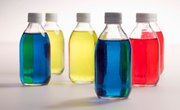
It is fine to pick up helium balloons from a store and take them home in your car, but it is definitely not a good idea to leave them in a hot car for a long time. This is because helium molecules get bigger when they heat up, so if your balloons keep getting hotter, they will eventually pop. If you do need to leave balloons in a car on a hot day, it is best to put them in the trunk away from direct sunlight.
Kinetic Theory of Matter
All matter has atoms and molecules that never stop moving. When you add heat to a substance, the molecules and atoms move even faster. But when atoms move faster, the space between them gets bigger, making the object expand and take up more space. (The mass of the object does not change, though.) The opposite happens when heat leaves a substance: The molecules move slower, and the atoms move closer to each other, making the object contract and take up less space. (Again, the mass does not change.) Solids, liquids and gases all expand when you add heat but in different ways.
Helium and Heat
Like all substances, helium molecules expand when you heat them. They are already less dense than air (this is why helium balloons float in the air), and heat makes them even denser. Helium is a gas, and like all gases its molecules move in all directions. When the gas molecules fly around in different directions, they collide with other objects and create pressure. In a helium balloon, the material of the balloon bears the brunt of this pressure. It is for this reason that balloon artists slightly under-inflate helium balloons during hot weather. If you move helium balloons into a cooler environment, you will notice them shrink a little because the opposite happens: The molecules contract and take up less space inside the material of the balloons.
Foil vs. Latex Balloons
Foil balloons and latex balloons have different properties, but helium expands inside a balloon regardless of its material. Foil balloons have a fixed volume, meaning the material has very little or no stretch. Latex (rubber) has more stretch than foil, but a latex balloon will still eventually pop when the expanding helium molecules stretch it to its limit because they exceed the maximum pressure the latex allows. Also, darker-colored balloons will absorb heat faster, and therefore pop quicker than lighter-colored balloons.
References
About the Author
Claire is a writer and editor with 18 years' experience. She writes about science and health for a range of digital publications, including Reader's Digest, HealthCentral, Vice and Zocdoc.
